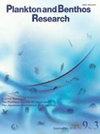东南亚商业捕捞水母、硬脊锥水母和粗壮叶水母的遗传多样性
IF 0.6
4区 生物学
Q4 MARINE & FRESHWATER BIOLOGY
引用次数: 0
摘要
根口水母Rhopilema hispidum和Lobonemoides robustus是东南亚最丰富和最重要的两个物种。然而,关于当地种群遗传多样性和连续性的信息仍然完全未知。我们利用遗传标记(COI和ITS1区域),在东南亚四个国家的11个地点研究了硬脊猪笼草和粗壮猪笼草的遗传结构和种群连续性。Rhopilema种群各位置间的遗传距离(ΦST)与地理距离呈正相关,表明它们处于距离隔离(IBD)状态。在Lobonemoides中,分子分析揭示了与采样位置相对应的三个不同的分支。粗壮L.robustus各位置之间的遗传距离表明,所有种群都保持着显著的隔离。我们的研究表明,这两个开花物种具有不同的系统地理模式,并且在遗传多样性和连续性方面存在差异。更新世和现今洋流系统期间的正常海平面变化,以及这两个物种生物学特征的差异,可以解释这些系统地理差异。我们的研究结果还表明,需要谨慎管理水母渔业,以避免当地种群灭绝,并保持这些物种的遗传多样性,尤其是粗壮L.robustus,它在每个地方都表现出相当大的基因多样性。本文章由计算机程序翻译,如有差异,请以英文原文为准。
Genetic diversities of commercially harvested jellyfish, Rhopilema hispidum and Lobonemoides robustus in Southeast Asia
The rhizostome jellyfishes, Rhopilema hispidum and Lobonemoides robustus, are two of the most abundant and commercially important species in Southeast Asia. However, information on genetic diversity and continuities among local populations remains totally unknown. We explored the genetic structure and population continuities of R. hispidum and L. robustus using genetic markers (COI & ITS1 regions) at 11 locations in four countries in Southeast Asia where fisheries were conducted. Rhopilema populations showed genetic distances (ΦST) among locations correlated positively with geographic distances, suggesting that they are in the isolation-by-distance (IBD). In Lobonemoides, molecular analysis revealed three distinct clades corresponding to sampling locations. Genetic distances among locations in L. robustus suggested that all populations maintain significant isolation. Our study reveals that these two blooming species have different phylogeographic patterns and differ in genetic diversity and continuities. Eustatic sea level changes during the Pleistocene and present ocean current systems, as well as differences in biological characteristics of these two species may explain these phylogeographic differences. Our results also suggest that jellyfish fisheries need to be carefully managed to avoid extinction of local populations and maintain the genetic diversity of these species, especially for L. robustus, which exhibits considerable genetic diversity in each location.
求助全文
通过发布文献求助,成功后即可免费获取论文全文。
去求助
来源期刊

Plankton & Benthos Research
Agricultural and Biological Sciences-Aquatic Science
CiteScore
1.30
自引率
0.00%
发文量
32
期刊介绍:
Plankton and Benthos Research is a peer-reviewed journal publishing quarterly original papers, reviews and notes dealing with any aspect of the biology and ecology of planktonic and benthic organisms and their interactions with the environment in any aquatic system, and is open to all scientists around the world. Submission of a paper is held to imply that it represents an original contribution not previously published and that it is not being considered elsewhere.
 求助内容:
求助内容: 应助结果提醒方式:
应助结果提醒方式:


